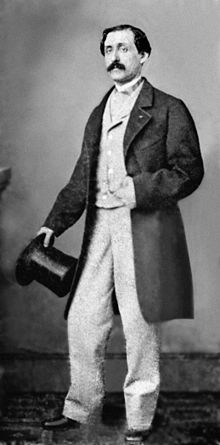Louis Moreau Gottschalk

Louis Moreau Gottschalk (May 8, 1829 – December 18, 1869) was an American composer and pianist, best known as a virtuoso performer of his own romantic piano pieces. Although he is regarded as an American composer and musician, he spent most of his working career outside of the United States.
Biography
Gottschalk was born to a Jewish businessman from London and a white Haitian Creole in New Orleans, where he was exposed to a wide variety of musical traditions. He had six brothers and sisters, five of whom were half-siblings by his father's mulatto mistress.[1] His family lived for a time in a tiny cottage at Royal and Esplanade in the Vieux Carré. Louis later moved in with relatives at 518 Conti Street; his Grandmother Buslé and his nurse Sally had both been born in Saint-Domingue (later known as Haiti). Gottschalk played the piano from an early age and was soon recognized as a wunderkind by the New Orleans bourgeois establishment. In 1840, he gave his informal public debut at the new St. Charles Hotel.
Only two years later at the age of 13, Gottschalk left the United States and sailed to Europe, as he and his father realized a classical training was required to fulfill his musical ambitions. The Paris Conservatoire, however, initially rejected his application on the grounds of his nationality. His examiner commented that "America is a country of steam engines". Gottschalk gradually gained access to the musical establishment through family friends.
After Gottschalk returned to the United States in 1853, he traveled extensively; a lengthy trip to Cuba in 1854 marking the beginning of a series of trips to Central and South America. By the 1860s, Gottschalk had established himself as the foremost pianist in the New World. Although born and reared in New Orleans, he was a supporter of the Union cause during the American Civil War. He returned to his native city only occasionally for concerts, but Gottschalk always introduced himself as a New Orleans native. In 1865, he was forced to leave the United States because of a scandalous affair with a student at the Oakland Female Seminary.
Gottschalk chose to travel to South America, where he continued to give frequent concerts. During one of these concerts, in Rio de Janeiro on November 24, 1869, he collapsed from having contracted malaria.[2] Just before his collapse, he had finished playing his romantic piece Morte!! (interpreted as "she is dead"), although the actual collapse occurred just as he started to play his celebrated piece Tremolo.
Gottschalk never recovered from the collapse. Three weeks later, on December 18, 1869, at the age of 40, he died at his hotel in Tijuca, Rio de Janeiro, Brazil, probably from an overdose of quinine.[2] In 1870 his remains were returned to the United States and were interred at the Green-Wood Cemetery in Brooklyn, New York.
His burial spot was originally marked by a magnificent monument, which has eroded over the years. The Green-Wood is seeking donations to restore the monument in his honor, the cost of which they estimate at $75,000[3]
His grand-nephew Louis Ferdinand Gottschalk was a notable composer of silent film and musical theatre scores.
Works

Gottschalk's music was very popular during his lifetime, and his earliest compositions created a sensation in Europe. Early pieces like "Le Bananier" and "Bamboula" were based on Gottschalk's memories of the music he heard during his youth in Louisiana. In this context, some of Gottschalk's work, such as the 13-minute opera Escenas campestres, retains a wonderfully innocent sweetness and charm.
Recordings
Various pianists later recorded his piano music. The first important recordings of his orchestral music, including the symphony A Night in the Tropics, were made for Vanguard Records by Maurice Abravanel and the Utah Symphony Orchestra. Vox Records issued a multi-disc collection of his music, which was later reissued on CD.
Other recordings include recent performances by Sakiko Oshashi, Amiram Rigai, and Michael Gurt.
References
- Irving Lowens/S. Frederick Starr: "Louis Moreau Gottschalk", Grove Music Online, ed. L. Macy (Accessed June 28, 2007), (subscription access)
Notes
- ^ Starr, S. Frederick 1995. Bamboula! The life and times of Louis Moreau Gottschalk. Oxford, N.Y. p22 et seq.
- ^ a b Lowens/Starr, Grove online
- ^ LOUIS MOREAU GOTTSCHALK, 1829–1869 Saved in Time, Green-Wood Cemetery
External links
- Louis Moreau Gottschalk, pianiste itinérant (French dedicated website with scores and audio extracts)
- Louis Moreau Gottschalk, a dedicated website
- Louis Moreau Gottschalk: Pioneering Pianist/Composer of the Americas (Catalogue of works, links to reference information)
- Biographical sketch
- Adam Kirsch, "Diary of a 'One-Man Grateful Dead'", The New York Sun, June 7, 2006.
- Free scores by Louis Moreau Gottschalk at the International Music Score Library Project (IMSLP)
Listening
- Art of the States: Louis Moreau Gottschalk six works by the composer
- Kunst der Fuge: Louis Moreau Gottschalk - MIDI files (piano works)
